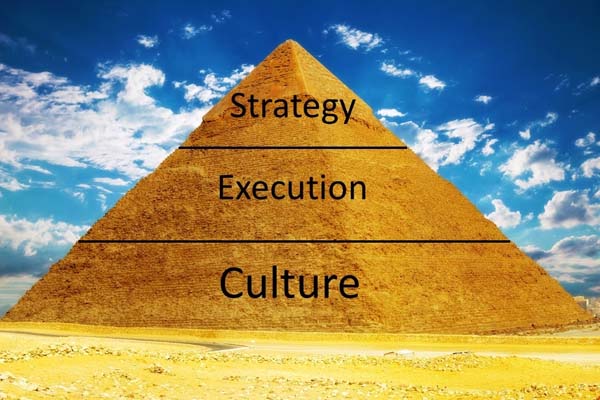29 Nov 2019 Who Said: “Culture Eats S______ For Breakfast”

“Culture eats strategy for breakfast”, a phrase originated by Peter Drucker and made famous by Mark Fields, President of Ford.
Cited in www.supplychain247.com
In this series of articles, I will share my experiences as an Executive Coach on the subject of Leadership.
If these articles resonate with you, please share them with your team and colleagues.
Also, if you’d like to discuss how Executive Coaching can help your team exceed your expectations, please contact me at Uri@thewilltochange.com
The Burning Oven
“It’s on fire. It’s completely ruined” Shouted the old woman at the customer care agent on the phone. “What is on fire, madam?” asked the agent. “Please explain and I will help you.”
“You don’t understand.” Shouted the old woman. “It is burning. It is on fire. Oh my god. What am I going to do?”. “Please, madam. Tell me what is on fire.” Said the agent. “My oven.” Shouted the old lady. “My oven is on fire. I just put in the pizza to bake and the oven went up in flames.” “Have you called 911?” Asked the agent. “No.” Said the woman. “It is not burning anymore. I managed to extinguish the fire.” Said the woman, as she was gradually calming down. “I want to speak to your CEO. Immediately. Your pizza caused my oven to go ablaze. Put me through to your CEO NOW.” Shouted the woman, as her temper flared again.
Thirty minutes later, John Rhodes, the VP of HR at Publix, who happened to live not far from the woman, showed up at her front door.”Madam, my name is John Rhodes. I am a Vice President at Publix. Our CEO sent me to help you fix the problem with our pizza and your oven.” “Come I’ll show you what happened. Your pizza completely ruined my beautiful oven.” “Don’t worry, madam. I am not leaving until we fix the problem.” He said.
As soon as he opened the over the door it was immediately obvious to John, that the woman’s oven had never been cleaned before. Ever. Piles of grease and burnt food were lying at the bottom of the oven. The remanence of countless meals and years of neglect. Unfortunately for Publix, it was their pizza which “broke the oven’s back.”
“What am I to do now?” John asked himself silently. But instead of getting frustrated, he pulled out his business card and read the words on the back: We will never knowingly disappoint you. These words told him exactly what he should do.
“Madam.” He said. “Give me 30 minutes. I’ll be back with everything I need to fix the problem. Here is my business card with my cell number.”
John drove quickly to the nearest Publix store, grabbed an oven scraper, cleaning materials, and two fresh pizza. Thirty minutes later he was back in the woman’s kitchen. John got on his knees and started scraping and cleaning the oven. Twenty minutes later the oven looked new. “Shall we bake the fresh pizza now and celebrate our victory?” He asked. By this time, the woman was enamored with John. “Yes. Why not.” She said. A few minutes later they opened a bottle of wine and savored the pizza, which tasted better than any they have ever tasted.
For months thereafter the CEO continued to recite John’s story as an example of Publix’s commitment to their service mission.
This story is “liberally based” on Frances Frei and Anne Morriss’ book Uncommon Service.
Publix’s strategy is not unique by any means. Just another grocery store chain, in the mid-west and south-east of the U.S. But what allowed them to grow to $25 billion in sales and 193,000 employees is their unwavering commitment to their core service value: We will never knowingly disappoint you.
Strategy, Execution, and Culture

Look at this pyramid. Would it survive if you were to slide the bottom layer from under the top two layers?
Clearly, all organizations need a winning strategy and an uncompromising ability to execute their strategy. But without a sound culture, they are bound to lose their competitive edge at some point during their lifetime.
Let’s consider briefly the top two layers, and then we’ll dive deeper into the bottom layer.
The Power of Strategy
Indeed, without a sound strategy success or even survival, will not be possible. Where would Amazon be without its strategy to move from selling books to selling everything. And where would it be without Amazon Web Services (AWS)? Where would Apple be without merging the iPod and the old flip-phone to create the iPhone? Consider Airbnb, Uber, Beyond Meat, Google, Facebook, and so many other disruptors, whose founders conceived a powerful vision.
But having an initial successful strategy is not sufficient for long term survival, without the courage and ability to change with the times. Just a few years ago, Blackberry had 30% of the mobile phone market. But their leaders failed to lead them through the fast-flowing river of technological evolution.
How about Wang Laboratories and Digital Equipment Corporation (DEC). Do you remember them?
We have witnessed so many sad stories like those of Toys R Us and Sears, who could not re-invent themselves. And it seems that envisioning and executing “recovery strategies” is much more difficult than developing the original winning strategies.
Execution – The Ingredient Without Which Strategy Will Not Blossom
Take Boeing, for example. A company that has only one major rival globally. And yet, due to a variety of factors, it has failed to execute its plans for the 737 Max. We may never know the exact reasons, but it is really disturbing to think that such an industry giant could fail so profoundly in its execution.
I am certain that you can come up with many of your own examples where poor execution has caused companies with brilliant ideas to under-deliver or even fail altogether.
This is such a rich topic, that I might dedicate a future article to it in the months to come.
Culture – The Secret Sauce That Makes It All Worthwhile
In 1992 IBM’s Board of Directors was looking for a new CEO to replace John Akers. At the time IBM was on the verge of being split into six smaller “Baby Blues”.
The Board gave the job to Lue Gerstner, the former CEO of the Oreo Cookies maker – Nabisco. It took Gerstner only a few short weeks to realize that the old culture that created this remarkably innovative, competitive, and customer-oriented company was all but gone. Gerstner knew that the only way he could “rescue” IBM was to change its failing culture, get rid of the arrogance and put the customer in the center again.
Harvard Professor, Frances Frei, loves Uber’s employees. “They are such a wonderful group of dedicated and capable people,” She said. Yet a few “bad apples” managed to intoxicate the culture of the company to a point of near-failure. Uber went through a lot of changes, and today, Says Professor Frei, Uber’s challenges are mainly refining its strategy and executing with excellence.
Conversely, Publix, the grocery chain, managed to cultivate a culture that will continue to attract and keep its customers, despite the premium it charges on the products it sells.
Culture – A Recipe For A Quick Implementation
Whether you are the CEO or a leader at any other level of the company, if you sense that the culture of your organization is not conducive to your values of social responsibility and business success, it is your responsibility to do everything you can to change it.
Here is how you can do it in a relatively short period of time.
- Your Values
The first step is to identify the core values that are most important to you and to your organization.
A Google search on “Corporate Values” reveals that many companies define the same guiding values, including:
- Integrity
- Innovation
- Customer Commitment
- Quality
- Respect for the Individual
- Team Work
- Winning Attitude
- Social Responsibility
Spending a couple of reflective hours and having a few conversations with your team will lead you to the list that resonates most with you and your people.
- Behaviors
The next step is to define in detail the behaviors that will manifest your values in the most common situations in the life of your company and all its component parts.
For smaller organizations, departments, or teams, I’d recommend getting together with your team and allowing them to think about and define the daily behaviors that will be congruent with the company values.
In larger organizations, you may want to ask your leadership team to conduct similar deliberations with their departments and teams.
You and your team should come up with challenging questions, such as: “How do we react if a customer calls to complain about our product or service with questionable proof?”, or “How do we react to a complaint about sexual harassment or improper behavior?”, or “At what point, if any, do we compromise on quality, because the cost might be too high?”
This process of allowing your people to define the behaviors that will support your values might take a while, and might consume a few person-hours, but it is extremely important, as it will demonstrate your genuine intensions with respect to the culture you are hoping to cultivate.
- Policies, Processes, and Systems
A “lenient” customer care policy will not be worth much without the specific policies, processes, and systems that will support efficient customer care.
Defining these policies, processes, and systems may take time and resources. Ideally, your team should prioritize the most impactful area to work on first.
For larger organizations, I recommend establishing a Process Support Group that will work on the initial definitions, and on the continuous improvement of these policies, processes, and systems.
- Communication
In addition to the formal corporate-wide initial communication of the “culture initiative”, I recommend that you task your direct reports, and the leaders reporting to them, to cascade the same messages to their people, formally and informally in every possible opportunity.
- Training
Here again, there should be an initial corporate-wide training effort to inform all employees of the values, behaviors, policies, processes, and systems.
Similar training should be also provided to all newcomers.
Additionally, refresher training should be provided to ensure that the desired manifestation of the company values and behaviors does not fade away from the day-to-day life of the company.
You should also communicate with and train your customers of any changes in your policies, processes, and systems that affect them.
- Top-down Practice
No culture can flourish or survive unless the CEO and her/his leadership team continuously and deliberately demonstrate their commitment to the core values and behaviors underlying that culture.
The power of the CEO or any senior leader demonstrating behaviors that support the desired behaviors, even in the most trivial of situations, cannot be overstated.
Every single day, the CEO should think about ways to propagate and hard-wire the desired values and behaviors into the psyche of the organization, through her/his direct reports, down to the next level, and the next level, and the next.
********
This process of cultivating a new culture may sound onerous and time-consuming, but it is absolutely worth it. In fact, for some companies, it may make the difference between thriving and mediocrity. If you are not yet convinced, I recommend that you further research the impact of corporate culture on business success. Hopefully, the results will resonate with you and will awaken the determination and energy you need to take whatever action you decide upon.
If you wish to explore how we can help you implement a “culture rejuvenation” initiative, please contact me at Uri@thewilltochange.com



